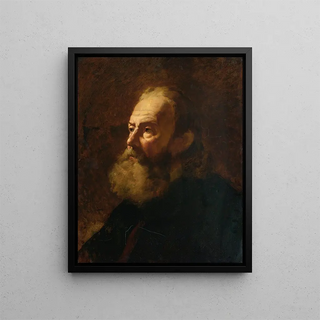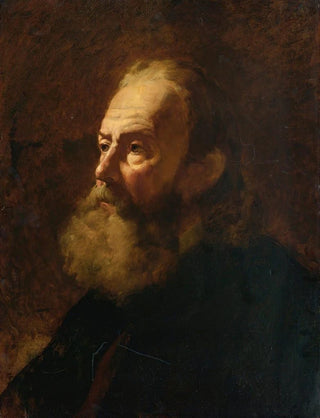Art print | Portrait of a bearded man in bust - William Etty Source: Reproduction | Portrait d'un homme barbu en buste - William Etty


View from behind

Frame (optional)
Portrait of a bearded man in bust - William Etty – Captivating introduction
In the vast panorama of art history, certain works stand out for their ability to capture the very essence of the human condition. The "Portrait of a bearded man in bust" by William Etty is one of those pieces that, through its psychological depth and striking realism, invites the viewer to introspective contemplation. This painting, which unfolds with rare intensity, evokes not only the personality of its subject but also the era in which it was created. Observing this portrait, one feels an immediate connection with the depicted man, as if his thoughts and emotions transcend time.
Style and uniqueness of the work
Etty's style is characterized by an exceptional mastery of light and color, elements that give his works an almost living dimension. In this portrait, warm nuances and delicate shadows sculpt the bearded face, emphasizing features marked by experience and wisdom. Etty's painting technique, which skillfully blends realism with a certain idealization, allows for the character of the model to be rendered with palpable emotional intensity. Every brushstroke seems to tell a story, revealing not only the external appearance of the man but also a depth of character that inspires admiration. This artistic approach, combining precision and expressiveness, makes this work a perfect example of the romantic portrait, where the individual is both a subject of study and a source of inspiration.
The artist and his influence
William Etty, born in 1787 in York, is often recognized as one of the pioneers of modern portraiture in Great Britain. His career, marked by a passion for representing the human body, was influenced by the great masters of painting, such as Titian and Rembrandt. Etty mastered the techniques of these giants while developing a personal style that is uniquely his own. His commitment to sincere representation of his subjects, particularly male figures, paved the way for many subsequent artists. In addition to his contribution to painting, Etty also played a key role in artistic education, encouraging a new generation of artists to

Matte finish

View from behind

Frame (optional)
Portrait of a bearded man in bust - William Etty – Captivating introduction
In the vast panorama of art history, certain works stand out for their ability to capture the very essence of the human condition. The "Portrait of a bearded man in bust" by William Etty is one of those pieces that, through its psychological depth and striking realism, invites the viewer to introspective contemplation. This painting, which unfolds with rare intensity, evokes not only the personality of its subject but also the era in which it was created. Observing this portrait, one feels an immediate connection with the depicted man, as if his thoughts and emotions transcend time.
Style and uniqueness of the work
Etty's style is characterized by an exceptional mastery of light and color, elements that give his works an almost living dimension. In this portrait, warm nuances and delicate shadows sculpt the bearded face, emphasizing features marked by experience and wisdom. Etty's painting technique, which skillfully blends realism with a certain idealization, allows for the character of the model to be rendered with palpable emotional intensity. Every brushstroke seems to tell a story, revealing not only the external appearance of the man but also a depth of character that inspires admiration. This artistic approach, combining precision and expressiveness, makes this work a perfect example of the romantic portrait, where the individual is both a subject of study and a source of inspiration.
The artist and his influence
William Etty, born in 1787 in York, is often recognized as one of the pioneers of modern portraiture in Great Britain. His career, marked by a passion for representing the human body, was influenced by the great masters of painting, such as Titian and Rembrandt. Etty mastered the techniques of these giants while developing a personal style that is uniquely his own. His commitment to sincere representation of his subjects, particularly male figures, paved the way for many subsequent artists. In addition to his contribution to painting, Etty also played a key role in artistic education, encouraging a new generation of artists to






